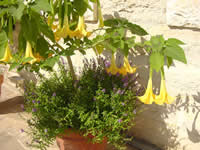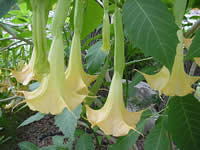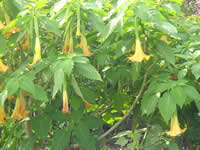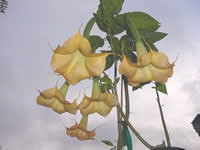|  Desperate
times and seemingly impossible situations call for drastic solutions.
Folks are "desperate" for plants which will grow and
hopefully bloom in the shade. With the deer and other wildlife
varmints on the increase and in a ravenous mode when it comes
to devouring our precious landscape plants, we are ready to use
anything and everything which might grow and bloom in the shade
yet escape the constant browsing of our Bambi "friends".
Realizing such plants must be distasteful, we must make plant
material selections from those plants that are labeled "poisonous".
The term "poisonous" means that if enough (usually larger
quantities than can be stomached or consumed because of distasteful
attributes) of the plant and/or plant parts are eaten, an individual
will become ill and possibly die. Animals and children are usually
repelled by the nasty-tasting plant after the first bite if they
are curious enough or hungry enough to experience a taste. This
aspect of plant protection is used by many of our favorite plants
such as lantana and oleander. Another plant which uses Desperate
times and seemingly impossible situations call for drastic solutions.
Folks are "desperate" for plants which will grow and
hopefully bloom in the shade. With the deer and other wildlife
varmints on the increase and in a ravenous mode when it comes
to devouring our precious landscape plants, we are ready to use
anything and everything which might grow and bloom in the shade
yet escape the constant browsing of our Bambi "friends".
Realizing such plants must be distasteful, we must make plant
material selections from those plants that are labeled "poisonous".
The term "poisonous" means that if enough (usually larger
quantities than can be stomached or consumed because of distasteful
attributes) of the plant and/or plant parts are eaten, an individual
will become ill and possibly die. Animals and children are usually
repelled by the nasty-tasting plant after the first bite if they
are curious enough or hungry enough to experience a taste. This
aspect of plant protection is used by many of our favorite plants
such as lantana and oleander. Another plant which uses this defense mechanism and is on the verge of becoming a Texas'
favorite has an angelic name - Angel Trumpet. The Angel Trumpet
is in the Brugmansia genus. Angel Trumpet is a Datura-type plant
but with the added advantage of not producing the poisonous seed
common with other Datura. The Angel Trumpet is repulsive to deer
(except for the fall rubbing of velvet off of antlers!), will
grow and bloom in semi-shaded areas, and, the most precious of
all its attributes, emits a wonderful Angelic scent at sundown
and into the evening hours while you are enjoying the cooling
nighttime temperatures. It is a dream-
this defense mechanism and is on the verge of becoming a Texas'
favorite has an angelic name - Angel Trumpet. The Angel Trumpet
is in the Brugmansia genus. Angel Trumpet is a Datura-type plant
but with the added advantage of not producing the poisonous seed
common with other Datura. The Angel Trumpet is repulsive to deer
(except for the fall rubbing of velvet off of antlers!), will
grow and bloom in semi-shaded areas, and, the most precious of
all its attributes, emits a wonderful Angelic scent at sundown
and into the evening hours while you are enjoying the cooling
nighttime temperatures. It is a dream- come-true-plant
for Texas. It gets its name from the large, long, trumpet-shaped
flowers which are abundant and emit a sweet, angelic-fragrance
in the evening. come-true-plant
for Texas. It gets its name from the large, long, trumpet-shaped
flowers which are abundant and emit a sweet, angelic-fragrance
in the evening.
The large shrubs or small trees of Angel's Trumpet (Brugmansia)
are grown for their very large, fragrant, pendent trumpet flowers.
They are still often found under the name Datura, but the true
Datura are short lived, herbaceous plants with smaller, more upright
flowers and capsular fruits that are usually prickly containing
very poisonous seed. The Angel's Trumpet will be root-hardy (freeze
to  the
ground most years but sprout again from the roots in the spring.)
in most areas of Texas except in extreme north Texas. Five or
more species are currently attributed to Brugmansia, most originating
in the Andes of northern South America, though even there they
seem always to be associated with human habitation. They are evergreen
or semi- evergreen and their leaves are large and soft, rather
like tobacco leaves but smaller, and all parts of the plant are
narcotic and poisonous. Remember, it is the dose that makes the
poison! Some plants considered "poisonous" are narcotic
or hallucinogenic if used in the correct "dosage", i.e.,
Mountain Laurel berries are deadly if chewed but were used to
make a mescal-like the
ground most years but sprout again from the roots in the spring.)
in most areas of Texas except in extreme north Texas. Five or
more species are currently attributed to Brugmansia, most originating
in the Andes of northern South America, though even there they
seem always to be associated with human habitation. They are evergreen
or semi- evergreen and their leaves are large and soft, rather
like tobacco leaves but smaller, and all parts of the plant are
narcotic and poisonous. Remember, it is the dose that makes the
poison! Some plants considered "poisonous" are narcotic
or hallucinogenic if used in the correct "dosage", i.e.,
Mountain Laurel berries are deadly if chewed but were used to
make a mescal-like  drink
by Indians who knew the safe "recipe-for-happiness".
The plants prefer a warm to hot climate and a light, fertile,
well-drained soil. They are best grown as small trees, they can
be shaped when young to obtain a single trunk or can be kept trimmed
as dense, rounded shrubs. Keep well watered during the growing
season. Whitefly and red spider mite populations should be controlled. drink
by Indians who knew the safe "recipe-for-happiness".
The plants prefer a warm to hot climate and a light, fertile,
well-drained soil. They are best grown as small trees, they can
be shaped when young to obtain a single trunk or can be kept trimmed
as dense, rounded shrubs. Keep well watered during the growing
season. Whitefly and red spider mite populations should be controlled.
SELECTIONS:
===================================================
'Charles Grimaldi' Angel Trumpet is named after a Californian
landscape designer, this 6 ft (1.8 m) tall hybrid cultivar ('Dr.
Seuss' X 'Frosty Pink') has very large, pendulous, fragrant, pinkish
yellow to salmon pink flowers, mainly from mid-fall (autumn) to
spring. It has very large leaves and with age will form quite
a thicket of stems.
===================================================
'Frosty Pink' Angel Trumpet is a hybrid which has large, pale
apricot-pink and white flowers and grows to around 6 ft (1.8 m)
tall. It has large, pale green leaves and forms clumps of stems.
The hybrid Brugmansia 'Ecuador Pink' is very similar, but has
flowers of pastel pink.
‘PINK PERFECTION’ FLOWER-WITHIN-A-FLOWER ANGEL TRUMPET
(BRUGMANSIA syn. Datura)
The ‘Pink Perfection’ Angel Trumpet produces individual flowers which are literally a flower-within-a-flower and is dark pink in color. So what is the difference between a flower-within-a-flower and a double or compound flower. The flower-within-a-flower blooms have a fully structured flower within another fully structured flower. It is an “extreme or perfect example of a double flower, i.e., to determine if a flower is a double flower rather than simply a lot of petals, look carefully at the petal structure of a bloom; if it appears to have a fully structured flower within another fully structured flower, it is likely an extreme double flower.
A “simple double flower” or compound flower is a plant in which extra petals are present, giving blooms a full or doubled appearance. Prized since ancient times, double flowers are somewhat difficult to cultivate, as many are sterile and must be regrown from cuttings rather than simple propagation. Genetic studies have shown that a double flower is the result of a specific genetic mutation, one rarely found in the wild. Certain types of flowers are more likely to have a double bloom than others. Roses, camellias, peonies, and carnations all commonly exhibit simple double flowers.
|



